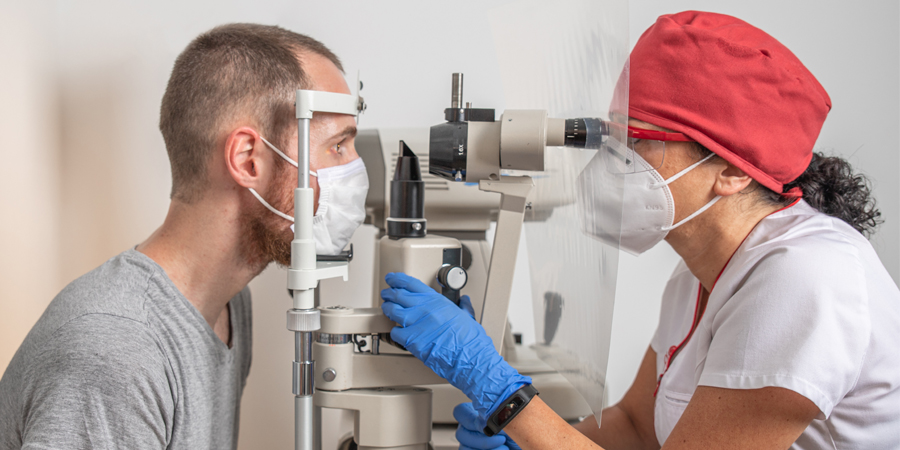As children are being confined at home staring at the screens up close due to the Covid-19, their eye care routine has become more important than ever. According to a study published in 2019, children’s refractive status may be more vulnerable to environmental changes.
The virtual classes that became necessary due to the effects of pandemic like lockdowns and stay-at-home orders can cause significant complications to your child’s eyesight. Parents who neglected their children’s eye care should consider a routine check-up at an eye care center to prevent any damage to your child’s eyes.
Let’s take a look at how this pandemic has damaged the sight of children:
Effects of pandemic: Should you worry about your child’s eyesight?
The effects of pandemic in the learning environment of your child can cause many problems to the eyesight of your child. With your child spending more time indoors and exposed to a lot of blue light from phone screens and computers during the pandemic, their eyesight can be affected in many ways. As a parent it is important for you to be aware of various eye conditions that children develop due to the lack of exposure to natural light and over exposure to blue light from gadget screens.
MYOPIA in Children is one of the Effects of Pandemic

Home confinement during the COVID-19 pandemic was connected to a substantial myopic shift in children aged 6 to 8 years, according to 2020 school-based photo tests. There should be several cautions that should be addressed, including the use of non-cycloplegic refractions and the lack of orthokeratology or ocular biometry data. Since younger children have a larger risk of developing myopia, they require proper eye care than older children.
Myopia is a serious eye condition that affects people around the world. According to the World Health Organization, half of the world’s population will be myopic by 2050. A lack of time spent engaging in outdoor activities has been highlighted as a major risk factor for the development of myopia in recent years. The duration and intensity of near-work activities are connected to myopia.
How Longer screen Time affects Children’s Eye Care
Effects of pandemic have led to long screen times and restless eyes among children. Headaches can result from gazing at phones, laptops, and tablets for long periods when they use digital gadgets, we tend to blink more slowly, preventing moisture from lubricating the surface of their eyes.
Children’s Eye Care to Prevent Dry Eye
A children’s eye specialist near me says that children are getting more affected with dry eye which is commonly seen in computer professionals spending long hours in front of the screen. It was less prevalent before the pandemic among children but now it is grown commonly in children. While using their laptops, phones, or tablets, they neglect to blink, resulting in dry eyes.
Children Stopped Wearing Near and Far Vision Glasses
One of the effects of pandemic is that many parents were not able to replace broken or damaged spectacles of their children. Most of the people who looked to buy replacement lenses online were not able to find the right power. Many customers who bought glasses online reported to be not fitting well for their children.
Early infancy is the most essential time for a child’s visual development. Blurry vision can inhibit the visual system from growing properly, which can lead to long-term problems. That is why youngsters must get their glasses back on track. Despite being aware of all the issues, parents neglect to visit an eye care center.
Eye Care for Neglected Lazy Eye
During COVID-19, some children with lazy eyes, either stopped wearing their eye patches or special spectacles. According to Dr. Shalini Jain many parents missed appointments for their eye test in Ghaziabad as the virus progressed.
Many of the children who came to Dr. Shalini Jain after COVID-19 had eye problems as a result of lack of regular follow-up with an ophthalmologist. The key to repairing lazy eyes is to resume eye treatment, which includes patching, eyeglasses, and regular checkups.
New Eye Diseases as Effects of Pandemic
According to ophthalmologists, children with strabismus, or misaligned eyes, have greater problems. Children’s eyes appear to be less controlled as they move inward and/or outward, and misaligned eyes appear to “drift” more noticeably. Doctors are confused about what’s causing the alterations, but they believe that it can be linked to eye fatigue and staring at displays up close for too long. To compensate for the increased misalignment, these children’s lenses will almost certainly need to be corrected.
Unnoticed Eye Problems
When daily visual interactions and activities are limited, it might be difficult to notice vision impairments. Younger children may not be able to convey their visual difficulties verbally or know how to do so.
Your child may have a visual problem if you notice him or her squinting at his or her work, complaining of fuzzy vision, or headaches. Find an eye care center for your child’s eye examination by searching online for a children’s eye specialist near me.
What can Parents do for their Children’s Eye Care
For both parent and child, virtual learning can feel confining. There are various things you can do at home to help your child’s vision, including the following:
- Reduce your exposure to blue light by wearing blue light glasses or using light filtering software (or by simply limiting your screen time).
- Encourage your child to engage in non-screen activities such as reading books, drawing, and coloring, playing games, solving puzzles, and assisting in the kitchen.
- Larger displays should be used, and they should be placed further away from children’s eyes.
- A monitor held at arm’s length is preferable to a phone or tablet held near to the face.
- Avoid using digital devices when lying down or reclining since it can cause neck and back pain and puts screens too close to children’s eyes.
- The 20-20-20 rule should be followed. Take breaks every 20 minutes, shifting eyes to look at an object at least 20 feet away for at least 20 seconds.
- Get outside for at least an hour per day. Exercise gives children’s eyes a break from digital devices. It’s a chance to focus on different distances and be in the sunlight.
- Take children to eye care centers for a general check-up.
- Visit a Children’s eye specialist Near me.
Read this blog to discover more about how covid-19 has affected children’s eyes and what parents can do to help their children’s eyes stay healthy.
Dr. Shalini Jain’s Samyak Eye Care Center is sought after for children’s eye test in Ghaziabad for their appropriate and on time diagnosis. For more information, visit: https://www.samyakeyecare.com/


